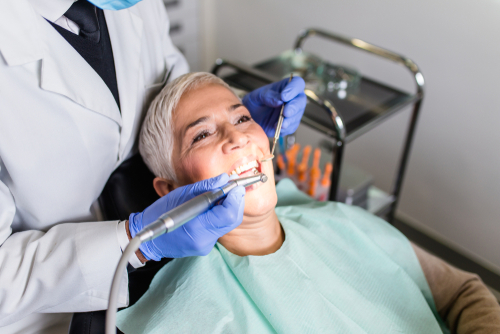Welcome to Smile Hilliard’s guide on scaling and root planing, a deep cleaning procedure for individuals with gum disease. We want to provide you with all the information you need to make informed decisions about your dental health.
At Smile Hilliard, we believe that the key to successful treatment lies in understanding our patients’ individual needs and goals. At Smile Hilliard, we prioritize education and quality dental care for our clients. Join us on a journey to a healthier smile.
Understanding Gum Disease
What is Gum Disease?: The Causes and Treatment
Gum disease is a common dental issue caused by plaque bacteria. Plaque can stick to your teeth and cause a chronic infection that can be slight to severe. Gingivitis is the precursor to gum disease and can be completely reversible because it only affects the gum tissue. On the other hand, gum disease (aka Periodontal Disease) is not reversible because it affects both gum tissue and the bone around the teeth. Other factors that increase your risk of gum disease are poor dental hygiene, smoking, diabetes, and hormonal changes. You are more at risk of developing gum disease because these factors weaken your immune system’s ability to fight off bacteria.
The Symptoms of Gum Disease
Recognizing the symptoms of gum disease is crucial for early intervention and treatment. Here are some common signs to watch out for:
- Bad breath: Persistent bad breath, also known as halitosis, can be an indicator. The accumulation of bacteria in the mouth can release unpleasant odors, causing chronic bad breath.
- Gum tissue changes: Swollen, red, or tender gums are often an early sign of gum disease. Healthy gums should appear pink and firm, so any changes in their appearance or texture should be taken seriously.
- Teeth sensitivity: Teeth sensitivity, especially sensitivity to hot and cold temperatures. If you experience discomfort or pain when consuming hot or cold foods and beverages, please contact us for an assessment.
- Additional symptoms of gum disease: Other symptoms may include bleeding gums( especially during brushing or flossing), receding gum lines, loose teeth, and the formation of deep pockets between the teeth and gums.
What is Scaling and Root Planing?
Scaling and root planing, also known as deep cleaning, is a non-surgical type of therapeutic care performed at Smile Hilliard. During this procedure, a dental hygienist removes plaque bacteria and tartar from the tooth surfaces and root surfaces below the gum line. Scaling removes the accumulated plaque and tartar, while root planing smooths the root surfaces, enabling the gum tissue to reattach to the teeth effectively.
The Need for Scaling and Root Planing
Deep gum pockets form because of a chronic bacterial infection which allows more bacteria to thrive and wreak havoc on oral health. This can lead to a devastating cycle of bacterial invasion and deepening gum pockets and bone loss. Scaling and root planing is the treatment to break the cycle of chronic infection and bone loss. If gum disease is left untreated, it can lead to tooth loss or the loss of multiple teeth. With our expertise and care, Dr. Sanyk and her team can help you get the deep clean you need to maintain optimal oral health.
The Scaling Procedure
Scaling is a process that utilizes specialized dental instruments and techniques to remove the bulk of plaque and tartar on the teeth. A dental ultrasonic scaler features a vibrating metal tip and water spray that effectively breaks down plaque and tartar buildup for the most efficient cleaning. By accessing areas that regular brushing and flossing cannot reach, scaling helps eliminate plaque bacteria, preventing further damage to gum tissue and bone.
The Root Planing Procedure
Root planing focuses on smoothing the rough surfaces of tooth roots to discourage the re-accumulation of plaque bacteria. After scaling, the dental professional uses special instruments to clean the tooth roots below the gum line. This process also removes inflamed and diseased tissue to stimulate healthy tissue to grow back in its place.
What to Expect
Scaling and root planing can be performed during a single visit or divided into multiple appointments, depending on the severity of gum disease, the doctor’s recommendation, and a patient’s individual preference. We will evaluate your specific condition and determine the most suitable approach. Before the procedure, local anesthesia may be administered to ensure a comfortable experience.
The American Dental Association endorses this treatment option and is typically recommended for patients who have been newly diagnosed with gum disease or those whose periodontal disease becomes active again. Surgical treatments may be necessary for advanced cases involving significant damage to the soft tissue.
Post-procedure Expectations
After scaling and root planing, you may experience minor discomfort and sensitivity. Reduced bleeding, healthier gums, and fresher breath are normal post-procedure. Adhere to prescribed oral care routines and attend follow-up appointments for the best results. Expect improved gum health, minimized tooth sensitivity, and reduced inflammation. Professional advice on maintaining good oral hygiene and regular dental checkups is necessary.
Benefits and Risks
The Advantages of the Procedure
The goals of scaling and root planing are to reduce deep pockets, prevent further bone loss, and stimulate the tissue to tighten around the teeth making them more stable. Removing bacterial film prevents dental problems and treats gum disease symptoms. Alongside good home care, this treatment, recommended by the American Dental Association, aids in maintaining oral health.
Any Potential Risks Involved
After the procedure, patients may notice increased sensitivity with their teeth. It’s essential to adhere to good home care and regular dental checkups to avoid complications. Dr. Sanyk will provide post-procedure care, including daily brushing and maintaining a balanced diet.
Is Scaling and Root Planing Painful?
Scaling and root planing are generally painless procedures. Local anesthesia is used to numb the treatment area, ensuring a comfortable experience. While mild discomfort during and after the procedure may occur, it is often manageable with over-the-counter medications. Your dental hygienist will provide care throughout the process to ensure you’re at ease.






